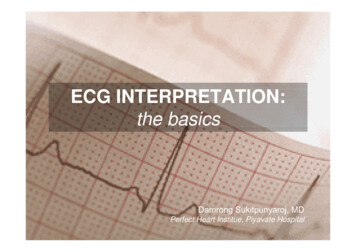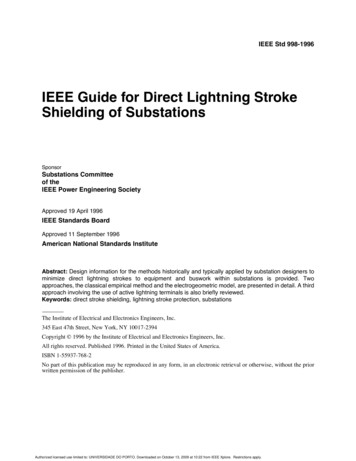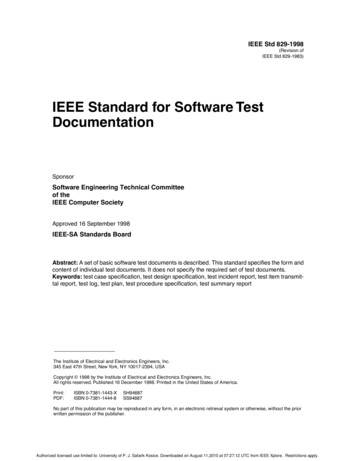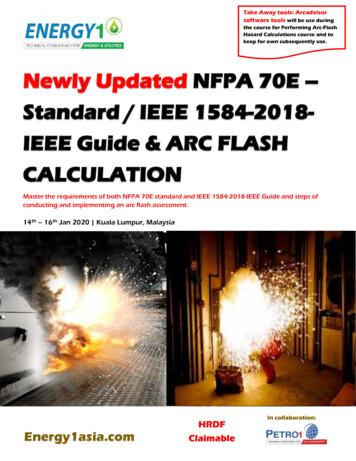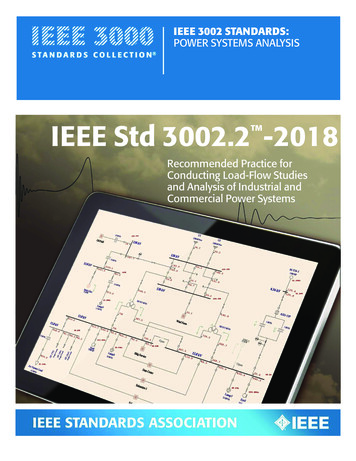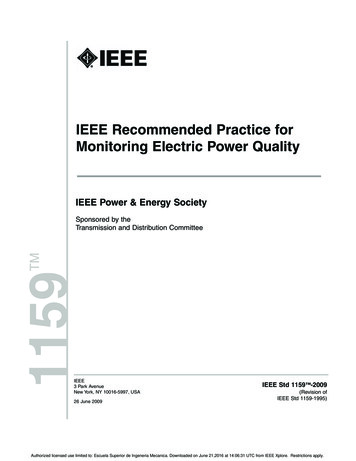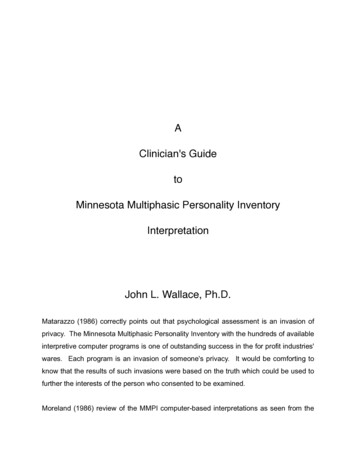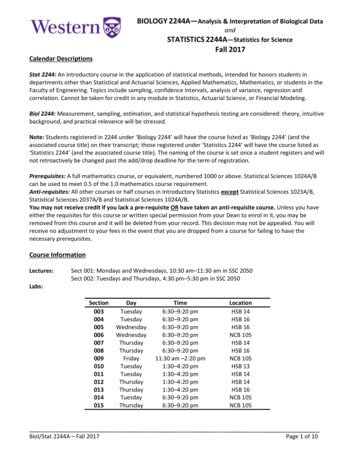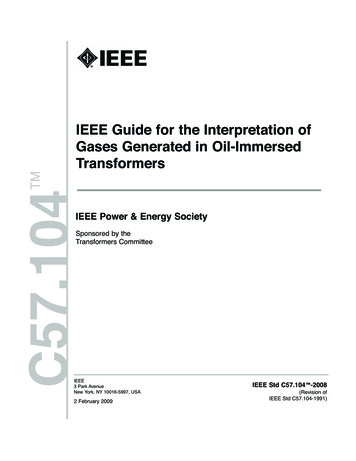
Transcription
C57.104TMIEEE Guide for the Interpretation ofGases Generated in Oil-ImmersedTransformersIEEE Power & Energy SocietySponsored by theTransformers CommitteeIEEE3 Park AvenueNew York, NY 10016-5997, USA2 February 2009IEEE Std C57.104 -2008(Revision ofIEEE Std C57.104-1991)
IEEE Std C57.104 -2008(Revision ofIEEE Std C57.104-1991)IEEE Guide for the Interpretation ofGases Generated in Oil-ImmersedTransformersSponsorTransformers Committeeof theIEEE Power & Energy SocietyApproved 26 September 2008IEEE-SA Standards Board
Abstract: Detailed procedures for analyzing gas from gas spaces or gas-collecting devices aswell as gas dissolved in oil are described. The procedures cover: 1) the calibration and use offield instruments for detecting and estimating the amount of combustible gases present in gasblankets above oil, or in gas detector relays; 2) the use of fixed instruments for detecting anddetermining the quantity of combustible gases present in gas-blanketed equipment; 3) obtainingsamples of gas and oil from the transformer for laboratory analysis; 4) laboratory methods foranalyzing the gas blanket and the gases extracted from the oil; and 5) interpreting the results interms of transformer serviceability. The intent is to provide the operator with useful informationconcerning the serviceability of the equipment. An extensive bibliography on gas evolution,detection, and interpretation is included.Keywords: gas analysis, oil, oil-filled transformers, transformers The Institute of Electrical and Electronics Engineers, Inc.3 Park Avenue, New York, NY 10016-5997, USACopyright 2009 by the Institute of Electrical and Electronics Engineers, Inc.All rights reserved. Published 2 February 2009. Printed in the United States of America.IEEE is a registered trademark in the U.S. Patent & Trademark Office, owned by the Institute of Electrical and Electronics Engineers,Incorporated.Second printing: 9 March 2009: A correction to Figure 3 is included in this printing.PDF:Print:ISBN 978-0-7381-5834-1ISBN 978-0-7381-5835-8STD95846STDPD95846No part of this publication may be reproduced in any form, in an electronic retrieval system or otherwise, without the prior written permissionof the publisher.
IEEE Standards documents are developed within the IEEE Societies and the Standards Coordinating Committees ofthe IEEE Standards Association (IEEE-SA) Standards Board. The IEEE develops its standards through a consensusdevelopment process, approved by the American National Standards Institute, which brings together volunteersrepresenting varied viewpoints and interests to achieve the final product. Volunteers are not necessarily members of theInstitute and serve without compensation. While the IEEE administers the process and establishes rules to promotefairness in the consensus development process, the IEEE does not independently evaluate, test, or verify the accuracyof any of the information or the soundness of any judgments contained in its standards.Use of an IEEE Standard is wholly voluntary. The IEEE disclaims liability for any personal injury, property or otherdamage, of any nature whatsoever, whether special, indirect, consequential, or compensatory, directly or indirectlyresulting from the publication, use of, or reliance upon this, or any other IEEE Standard document.The IEEE does not warrant or represent the accuracy or content of the material contained herein, and expresslydisclaims any express or implied warranty, including any implied warranty of merchantability or fitness for a specificpurpose, or that the use of the material contained herein is free from patent infringement. IEEE Standards documentsare supplied “AS IS.”The existence of an IEEE Standard does not imply that there are no other ways to produce, test, measure, purchase,market, or provide other goods and services related to the scope of the IEEE Standard. Furthermore, the viewpointexpressed at the time a standard is approved and issued is subject to change brought about through developments in thestate of the art and comments received from users of the standard. Every IEEE Standard is subjected to review at leastevery five years for revision or reaffirmation. When a document is more than five years old and has not beenreaffirmed, it is reasonable to conclude that its contents, although still of some value, do not wholly reflect the presentstate of the art. Users are cautioned to check to determine that they have the latest edition of any IEEE Standard.In publishing and making this document available, the IEEE is not suggesting or rendering professional or otherservices for, or on behalf of, any person or entity. Nor is the IEEE undertaking to perform any duty owed by any otherperson or entity to another. Any person utilizing this, and any other IEEE Standards document, should rely upon his orher independent judgment in the exercise of reasonable care in any given circumstances or, as appropriate, seek theadvice of a competent professional in determining the appropriateness of a given IEEE standard.Interpretations: Occasionally questions may arise regarding the meaning of portions of standards as they relate tospecific applications. When the need for interpretations is brought to the attention of IEEE, the Institute will initiateaction to prepare appropriate responses. Since IEEE Standards represent a consensus of concerned interests, it isimportant to ensure that any interpretation has also received the concurrence of a balance of interests. For this reason,IEEE and the members of its societies and Standards Coordinating Committees are not able to provide an instantresponse to interpretation requests except in those cases where the matter has previously received formal consideration.A statement, written or oral, that is not processed in accordance with the IEEE-SA Standards Board Operations Manualshall not be considered the official position of IEEE or any of its committees and shall not be considered to be, nor berelied upon as, a formal interpretation of the IEEE. At lectures, symposia, seminars, or educational courses, anindividual presenting information on IEEE standards shall make it clear that his or her views should be considered thepersonal views of that individual rather than the formal position, explanation, or interpretation of the IEEE.Comments for revision of IEEE Standards are welcome from any interested party, regardless of membership affiliationwith IEEE. Suggestions for changes in documents should be in the form of a proposed change of text, together withappropriate supporting comments. Comments on standards and requests for interpretations should be submitted to thefollowing address:Secretary, IEEE-SA Standards Board445 Hoes LanePiscataway, NJ 08854USAAuthorization to photocopy portions of any individual standard for internal or personal use is granted by The Instituteof Electrical and Electronics Engineers, Inc., provided that the appropriate fee is paid to Copyright Clearance Center.To arrange for payment of licensing fee, please contact Copyright Clearance Center, Customer Service, 222 RosewoodDrive, Danvers, MA 01923 USA; 1 978 750 8400. Permission to photocopy portions of any individual standard foreducational classroom use can also be obtained through the Copyright Clearance Center.
IntroductionThis introduction is not part of IEEE Std C57.104-2008, IEEE Guide for the Interpretation of Gases Generated inOil-Immersed Transformers.IEEE Std C57.104-1991 was officially withdrawn by IEEE based on recommendation by the TransformersCommittee of the IEEE Power & Energy Society at the end of 2005. The intent of this document has beenfocused on making minor changes to address some of the most pressing issues (such as correcting typos,factual errors, and the values listed in Table 1 of the 1991 version of the guide), and to publish this guidefor use by the industry.Upon publication of this document, the working group plans to immediately begin the process of furtherrevision to the guide to reflect additional advances in current knowledge and trends, and to incorporaterelevant material presented during a previous unsuccessful attempt to revise the guide.Notice to usersLaws and regulationsUsers of these documents should consult all applicable laws and regulations. Compliance with theprovisions of this standard does not imply compliance to any applicable regulatory requirements.Implementers of the standard are responsible for observing or referring to the applicable regulatoryrequirements. IEEE does not, by the publication of its standards, intend to urge action that is not incompliance with applicable laws, and these documents may not be construed as doing so.CopyrightsThis document is copyrighted by the IEEE. It is made available for a wide variety of both public andprivate uses. These include both use, by reference, in laws and regulations, and use in private selfregulation, standardization, and the promotion of engineering practices and methods. By making thisdocument available for use and adoption by public authorities and private users, the IEEE does not waiveany rights in copyright to this document.Updating of IEEE documentsUsers of IEEE standards should be aware that these documents may be superseded at any time by theissuance of new editions or may be amended from time to time through the issuance of amendments,corrigenda, or errata. An official IEEE document at any point in time consists of the current editionof the document together with any amendments, corrigenda, or errata then in effect. In order to determinewhether a given document is the current edition and whether it has been amended through theissuance of amendments, corrigenda, or errata, visit the IEEE Standards Association Web site athttp://ieeexplore.ieee.org/xpl/standards.jsp, or contact the IEEE at the address listed previously.For more information about the IEEE Standards Association or the IEEE standards development process,visit the IEEE-SA Web site at http://standards.ieee.org.ivCopyright 2009 IEEE. All rights reserved.
ErrataErrata, if any, for this and all other standards can be accessed at the following /errata/index.html. Users are encouraged to check this URLfor errata periodically.InterpretationsCurrent interpretations can be accessed at the following URL: x.html.PatentsAttention is called to the possibility that implementation of this guide may require use of subject mattercovered by patent rights. By publication of this guide, no position is taken with respect to the existence orvalidity of any patent rights in connection therewith. The IEEE is not responsible for identifying EssentialPatent Claims for which a license may be required, for conducting inquiries into the legal validity or scopeof Patents Claims or determining whether any licensing terms or conditions provided in connection withsubmission of a Letter of Assurance, if any, or in any licensing agreements are reasonable or nondiscriminatory. Users of this guide are expressly advised that determination of the validity of any patentrights, and the risk of infringement of such rights, is entirely their own responsibility. Further informationmay be obtained from the IEEE Standards Association.vCopyright 2009 IEEE. All rights reserved.
ParticipantsAt the time this guide was submitted to the IEEE-SA Standards Board for approval, the DGA GuideWorking Group had the following membership:Richard Ladroga, ChairSusan McNelly, SecretaryClaude BeaucheminOscar BelloPaul BomanBill ChiuC. Clair ClaiborneJerry CorkranJohn CrouseWilliam DarovnyJim DukarmJames GardnerJames GrahamBill GriesackerJoseph KellyStan LindgrenJames McIverKent MillerDan PercoDonald PlattsThomas PrevostTimothy RaymondHyeong SimBrian SparlingDavid WallachBarry WardJim ZhangThe following members of the individual balloting committee voted on this guide. Balloters may havevoted for approval, disapproval, or abstention.William J. AckermanSteven AlexandersonI. AntweilerStan ArnotCarlo ArpinoAli Al AwaziBarry BeasterStephen BeattieRobert BeaversW. J. (Bill) BergmanWallace BinderThomas BishopThomas BlackburnThomas BlairSteven BrockschinkChris BrooksKent BrownCarl BushJames CaseDonald CashJuan CastellanosBill ChiuC. Clair ClaiborneStephen ConradTommy CooperJerry CorkranStephen DareWillaim DarovnyAlan DarwinJohn DensleyDieter DohnalDonald DunnFred ElliottGary EngmannDonald FallonGene Del FiaccoJoseph FoldiBruce ForsythMarcel FortinJames GardnerSaurabh GhoshJames GrahamRandall GrovesKenneth HanusRobert HartgroveGary HeustonScott HietpasDavid HorvathJames HuddlestonFrancis HuguetR. JacksonJames JonesLars JuhlinRobert KeefeJoseph KellyGael KennedyJoseph L. KoepfingerNeil KranichDavid W. KrauseJim KulchiskySaumen KunduJohn LackeyRichard LadrogaChung-Yiu LamStephen LambertDebra LongtinWilliam LoweThomas LundquistG. LuriKeith N. MalmedalJ. Dennis MarlowJohn W. MatthewsWilliam McDermidSusan McNellyJoseph MelansonGary MichelDaniel MulkeyJerry MurphyR. MusilMichael S. NewmanviCopyright 2009 IEEE. All rights reserved.Raymond NicholasJoe NimsRobert OlenJ. PattonChristopher PetrolaDonald PlattsAlvaro PortilloBertrand PoulinGustav PreiningerThomas PrevostIulian ProfirJeffrey RayJohannes RickmannMichael RobertsCharles RogersJohn RossettiThomas RozekDinesh Pranathy SankarakurupDaniel SauerBartien SayogoDevki SharmaHyeong SimJames E. SmithSteve SnyderJohn SpareBrian SparlingS. ThamilarasanJames ThompsonT. TraubJohn VergisDavid WallachBarry WardWilliam WessmanKenneth WhiteWilliam WimmerRoland YoungbergKipp YuleTheodore ZeissWaldemar ZiomekAhmed Zobaa
When the IEEE-SA Standards Board approved this guide on 26 September 2008, it had the followingmembership:Robert M. Grow, ChairThomas Prevost, Vice ChairSteve M. Mills, Past ChairJudith Gorman, SecretaryVictor BermanRichard DeBlasioAndy DrozdMark EpsteinAlexander GelmanWilliam GoldbachArnie GreenspanKen HanusJim HughesR
C57.104 Transformers Committee TM. IEEE Std C57.104 -2008 (Revision of IEEE Std C57.104-1991) IEEE Guide for the Interpretation of Gases Generated in Oil-Immersed Transformers Sponsor Transformers Committee of the IEEE Power & Energy Society Approved 26 September 2008 IEEE-SA Standards Board. Abstract: Detailed procedures for analyzing gas from gas spaces or gas-collecting


